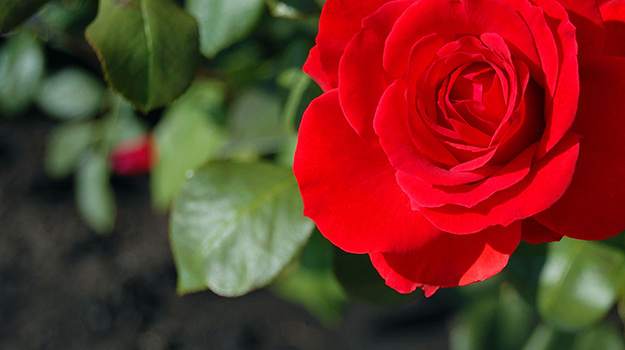
Roses are an amazing asset in a garden. Wonderfully scented, they come in all colours except blue. There are bushy, climbing, trailing, dwarf and semi-dwarf varieties. Varying in tallness, they can fill empty spaces in flower beds, be used as feature plants, fit into an arrangement of shrubs, cover a wall, form a plant screen or a hedge... In short, they find their place anywhere in the garden!
Some aren’t demanding at all (read our article: Easy roses for gardeners with little time). Others are a bit fussier and require regular care. No matter which variety you choose, here’s what to consider so your plants easily adapt to their new environment and give the best possible results.
- Sufficient light
- Sufficient aeration to help prevent fungal diseases
- Ideally, a spot offering protection from cold and drying winds
- Soil adapted to their needs
- Proper watering
- The nutrients they need to thrive
How to determine where to plant roses?
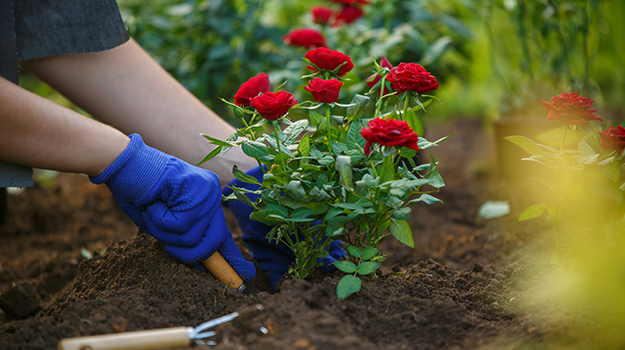
Choose a sunny spot. Most roses need at least 6 hours of light per day, ideally in the afternoon.
However, some shrub roses give surprisingly good results in partial shade (4 to 6 hours of light). It is the case with Alba and Ballarina roses, as well as hybrid ground covers from the Rosa Moschita family. Their impressive flowering is proof of this!
They are hardy bush roses that require little maintenance and have been popular in the garden for a very long time. Cultivated since Antiquity, the Alba rose bears fragrant flowers (single or double) and withstands temperatures down to -30 °C, while the Rosa Moschita, the famous rosehip, is said to have been introduced into European gardens before the 16th century. Finally, the Ballarina offers clusters of pinkish-white flowers similar to those of an apple tree. As those cultivars all come in white or pinkish white, they are perfect to brighten up darker areas.
To learn more about roses, read our article 25 Easy, low-maintenance roses.
The ideal soil for roses
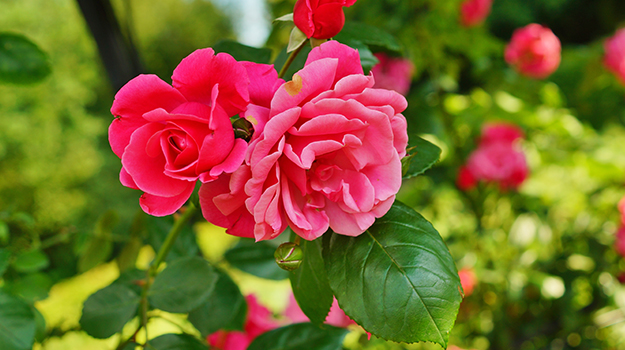
Roses appreciate a well-drained soil that retains moisture (as they are very sensitive to drought conditions). Adding organic matter or a potting soil containing peat moss, such as PRO-MIX Premium All Purpose Mix, improves the soil and provides favourable conditions for their development.
In general, roses prefer a soil that’s deep, rich in organic matter and slightly clayey. However, some varieties thrive admirably in sandy soils. It is the case with Rosa Rugosa hybrids, including the old hardy roses, the Pavement series (salt-resistant) and also the very popular Explorer and Canadian Artists series created by Agriculture Canada.
This means that even if your soil isn’t absolutely perfect, there are several options out there, including roses that are worthy of a flower shop.
OUR TIP As sandy soils drain easily, adding peat moss will help retain water and fertilizer longer.
Soil pH
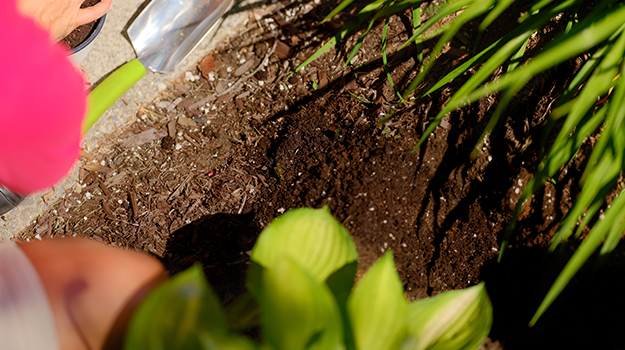
The soil acidity level is also important. A pH of 6.5 or 7 allows the roots to properly absorb minerals. Excessively acidic soils can be corrected by adding lime, while excessively alkaline soils need sulfur. The results, however, aren’t immediate. It takes two to four months to see improvement in acidic soils… and up to three years in the case of amended alkaline soils.
OUR TIP If the soil doesn’t drain well where you chose to plant your rose, simply raise the bed 20 cm above ground level by adding quality potting soil. Used by professional gardeners and landscapers, this technique is not only aesthetic, but it also makes planting easier as it doesn’t require you to loosen the soil very deeply!
How to plant roses?
Simplified soil preparation
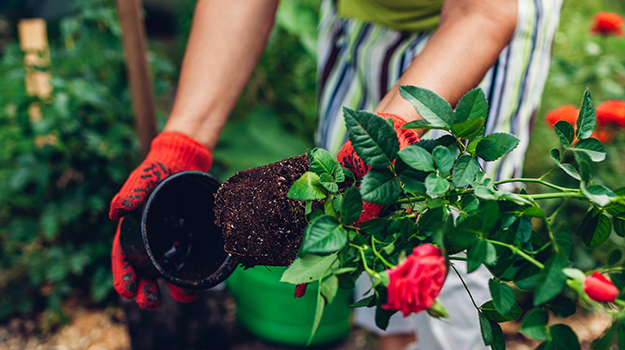
- Remove the grass using an edger or a shovel.
- Loosen the soil to a depth of 45-60 cm.
- Amend your soil by adding 4 to 5 cm of organic matter (quality soil with peat moss and/or compost) and lime or sulfur if you need to adjust the soil’s pH. This will help with water and nutrient retention in sandy soils, and will improve drainage in compact, clayey soils.
- Water your plant before planting so its root mass is moist and the soil stays in place when you take the plant out of its pot.
OUR TIP You’re creating a new flower bed for your roses? Use a garden hose to outline a bed with smooth, natural curves. Once you’re done and satisfied, simply cut the grass using an edger or spade shovel!
8 easy steps to plant roses
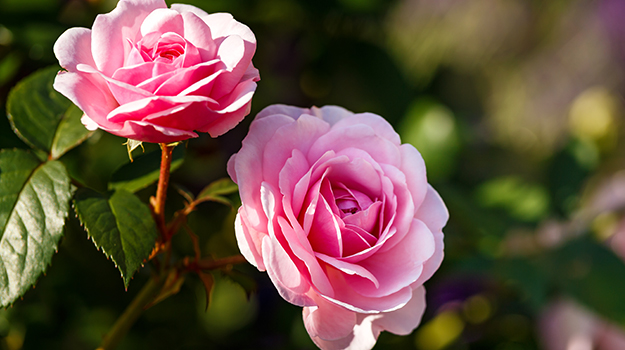
While bare root roses need to be planted early in the spring, roses sold in pots can be planted throughout the season. When the weather is particularly hot, however, make sure your plants have enough water. Water generously before and after planting.
- Dig a hole twice as deep as the root mass, and two to three times wider so the roots have room to spread.
- For grafted roses (with a visible callus at the base), dig a deeper hole, so that you can bury the grafting point. In zone 5, the grafting point should be 5 cm below ground level, in zone 4 at a depth of 8 cm, and in zone 2 or 3, at a depth of 10 to 15 cm. This will protect the graft (the cultivar you have chosen) from the cold.
- Place your rose in the centre of the hole and spread its roots all around.
- Apply mycorrhizae on the roots. This will minimize the transplant shock and help the root system develop. The mixes offered by PRO-MIX include the exclusive MYCOACTIVE technology. Perfect to quickly grow bigger and more vigorous plants with lots of blooms.
- Add quality soil to fill half of the planting hole, giving it a bowl-like shape.
- Water generously and let the water filter in before filling completely.
- Compress the soil lightly to remove any air pockets, then water again. Watering in two phases ensures that the water reaches the roots.
- Apply mulch to retain soil moisture and keep weeds in check. There are more pleasant things than weeding around a rose shrub!
OUR TIP You fell for a rose bush with bright pink double flowers but the following year it’s loaded with single roses that are small and white? Knowingly or not, you bought a grafted rose bush and didn’t bury the grafting point properly. The rose you have chosen (the graft) did not survive the winter, but the rootstock did. It’s what you’re looking at now.
Space plants as recommended
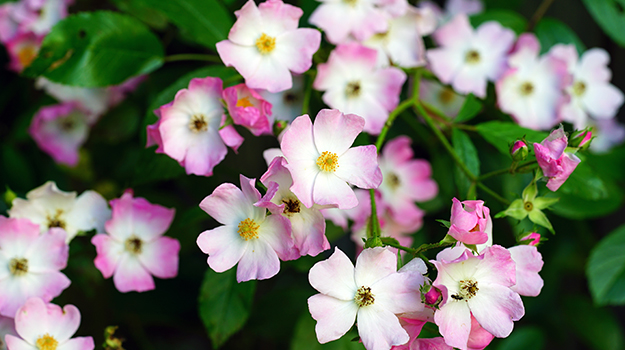
Respecting the recommended spacing between plants will allow you to leave them in place once they are mature. Once well established, roses do not appreciate being moved. Even if a tight arrangement seems more appropriate, remember that good air circulation helps prevent certain diseases in roses.
Recommended spacing
- Miniature roses: 20 to 30 cm
- Hybrid tea, floribunda and grandiflora roses: 60 cm
- Shrub roses: 1 to 2 m depending on the width at maturity
- Climbing roses: 1.5 to 2.5 m depending on the cultivar (check label)
In the case of hedges, you can cheat a little to create an effect of continuity. Note that roses also make great informal hedges. If you prune them too often in an attempt to control them, your hedge will be thin, there will be very few flowers and your plants will suffer. Read our article: How to prune roses.
OUR TIP Conifers and roses get along well. With deciduous trees, it’s a different story. To prevent all competition for the water and nutrients in the soil, it’s better to keep some distance between them. Avoid planting roses under the crown of deciduous trees, and even beyond in the case of large trees with spread-out roots.
How to water roses?

Roses hate being thirsty. It’s important that they always have enough water, especially at the start of the season and when they bloom again. When the weather is nice and warm, water your rose deeply, ideally early in the morning so that its foliage can dry quickly.
Roses prefer consistently moist (but well-drained!) soil over dry soil. To find out if you need to water, stick your finger into the soil. Water only if the soil feels dry to a depth of 5 cm. During heat waves, especially the first few years, be sure to water them well.
Regarding watering, using a soaker or sprinkler hose allows you to water over a long period without eroding the soil. Watering at the base without wetting the leaves also helps to prevent fungal diseases.
Finally, applying a thick layer of mulch at their foot allows to retain water and reduce the watering frequency.
OUR TIP Avoid watering in full sun. Although water drops do not burn the foliage, as believed by many, the water will evaporate too quickly and it won’t be as effective.
When and how to fertilize roses?
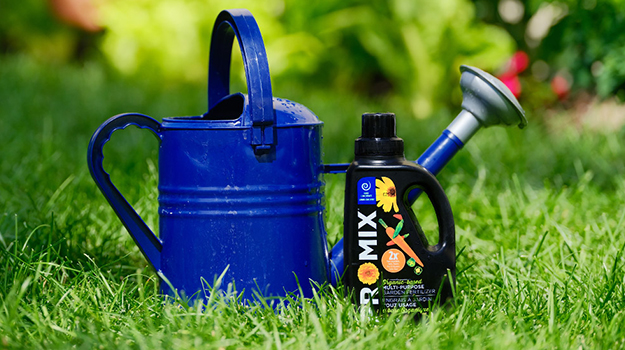
Roses are heavy feeders. Regular and balanced fertilization guarantees vigorous growth and lots of blooms. The first year, if you enriched the soil before planting your new rose, fertilizing isn’t essential. But it can be done after your roses have flowered.
Here’s how to fertilize your roses the following years:
- In May, feed with a high-nitrogen fertilizer such as PRO-MIX Organic-Based Multi-Purpose Garden Fertilizer 2-6-6.
- In early July, choose a formula with a concentration of phosphorus to promote the development of flower buds. Our choice: PRO-MIX Premium Organic-Based Flower Boost Garden Fertilizer Fertilizer 12-28-12.
- Stop fertilizing toward the end of July to avoid stimulating new growth, which would not survive the cold conditions to come.
OUR TIP Water the soil before applying fertilizer and never exceed the recommended amounts.
To learn how to take care of your rose, read our article When to prune roses.
